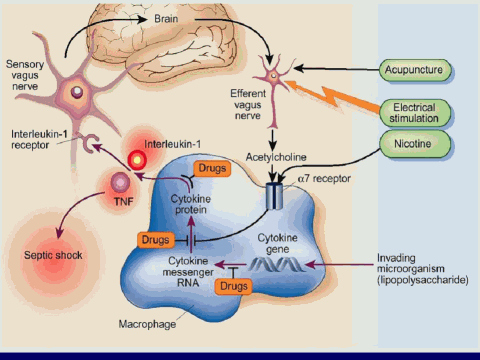| front |1 |2 |3 |4 |5 |6 |7 |8 |9 |10 |11 |12 |13 |14 |15 |16 |17 |18 |19 |20 |21 |22 |23 |24 |25 |26 |27 |28 |29 |30 |31 |32 |33 |34 |35 |36 |37 |review |
 |
The inflammatory
response to microorganisms, and ways of controlling it. The inflammatory response to microorganisms, and ways of controlling it. Clockwise from lower right: many bacteria contain lipopolysaccharide in their cell walls, which stimulates macrophages. These immune cells then make and release various cytokine ('alarm') molecules, including tumour-necrosis factor (TNF) and interleukin-1. But too much TNF in the blood can be harmful, leading to excessive inflammation and septic shock. Several drugs (orange boxes) inhibit steps in TNF synthesis. In addition, Tracey and colleagues have found that when the vagus nerve detects interleukin-1 (left), it releases acetylcholine (right), which binds to the [alpha]7 receptor 2 on macrophages and inhibits cytokine production. This suggests possible new ways of controlling inflammation: through electrically stimulating the vagus nerve, by acupuncture, or with the use of nicotine (which mimics acetylcholine) Libert: Nature, Volume 421(6921).January 23, 2003.328-329 |